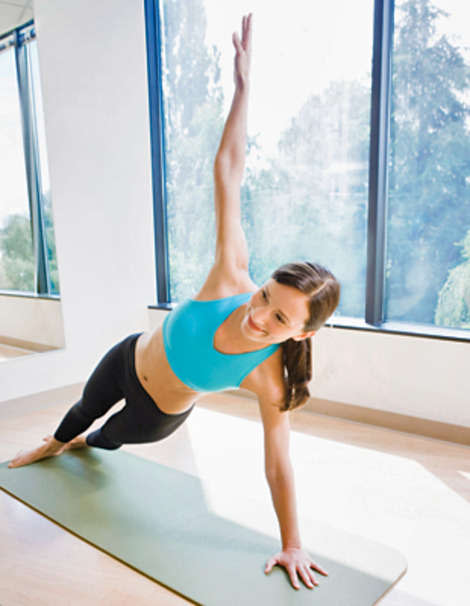Couch Potato Alert: 3 Back Stretches to Do in Front of Your TV

By Mollie Bloudoff-Indelicato, Everyday Health
Back pain is the most commonly reported type of pain - more than a quarter of all U.S. adults experience back pain at some point, according to a National Institutes of Health survey.
While you might not be able to completely avoid back pain, you can control its intensity and its duration. The way to do that is to build a strong core, said Patrick Roth, MD, the chairman of neurosurgery at Hackensack University Medical Center in New Jersey. Stretching is an integral part of building that strength.
RELATED: 7 Bad Habits That Cause Back Pain
"[These stretches] are the simplest thing you can do that takes almost no time," said Dr. Roth, who recently wrote a book, "The End of Back Pain," on this topic. "It'll help reduce the frequency, duration and intensity of back pain, and you can do this while you're watching TV."
So forget sit-ups, and don't bother with marathon runs. If done correctly, Roth's three stretches will strengthen your muscles to help prevent pain. Here's how:
1. Kneeling Swimmer's Stretch
This exercise strengthens your back muscles and also serves as a warm-up. This exercise should be done slowly in one continuous motion. It can be made more difficult by either increasing the number of reps or by holding each rep for a slightly longer time. This will help to improve endurance and develop your balance. Feel the muscles in your back being targeted. Your shoulder and your buttocks will automatically be used. Try to fully extend your arm and leg on each repetition.
RELATED: How to Exercise With Arthritis and Sore Joints
Here's how to do it:
Get on your hands and knees on an exercise mat, with your knees directly under your hips and your wrists directly below your shoulders, fingers pointed forward.
Tighten your abdominal muscles to stabilize your spine. Keeping your head in a neutral position, simultaneously extend your left arm in front of you until it is parallel to the ground while you extend your right (opposite) leg so it is also parallel to the ground.
Keep your spine and head aligned; do not allow your back to sag or arch. Hold this position for two seconds and return to your starting position.
Repeat, reversing the position with your right arm forward and your left leg pointing backward, keeping your spine in a neutral position throughout.
If this move causes shoulder discomfort, support your upper body on a chair or exercise ball and perform only the leg extension portion.
2. Front Plank
This is a great core exercise that, if done correctly, will strengthen your abdominal muscles without injuring your spine. Simply hold the front plank position while breathing normally for 10 seconds to start, adding time as you become stronger. Focus on keeping your body straight. The goal is to shorten the distance between your rib cage and your pelvis.
RELATED: The 5-Minute Workout That Will Shed Your Winter Weight
Here's how to do it:
Lie on your stomach with your elbows close to your sides and directly under your shoulders, palms down and hands facing forward.
Contract the muscles in the front of your thighs to extend your legs and pull toes towards your shins. Contract your core and abdominal muscles.
Slowly lift your entire torso off the floor or mat, maintaining a stiff torso and legs.
Avoid any arching (sagging) in your low back, hiking (upward) in your hips or bending in the knees. Avoid shrugging your shoulders, and keep your shoulders positioned directly over your elbows with your palms facing down.
Stop if your hips begin to hike up or drop down or you are otherwise unable to maintain the proper form. If you experience back pain, lift your hips slightly.
3. Side Plank
This exercise will strengthen the lateral part of your core, the internal and external obliques. Focus on keeping your body straight. You will feel the muscular fatigue in the side closer to the ground.
RELATED: Is Your iPad Causing Your Chronic Pain?
Here's how to do it:
Lie on your side, and prop yourself up on one elbow and forearm with your other arm straight down to your side.
Keep your legs out to your side with your feet stacked on top of each other.
Contract your abdominals and raise your hips off the ground until your body forms a straight line. Keep your body straight (don't let your hips drop).
Simply hold the position (breathing normally) for 10 seconds to start, adding time as you become stronger.
Stop if you are unable to maintain proper form, or support your weight on your knee rather than your feet, which will make the exercise easier.
MORE ON EVERYDAY HEALTH:
7 Things You Never Knew Lemons Could Do
Meet Wendy - Polar Explorer and Dog Musher With MS
Dr. Sanjay Gupta: Heat May Relieve Asthma When Medicines Aren't Enough
What to Order at the Smoothie Bar
This article originally appeared on EverydayHealth.com: Couch Potato Alert: 3 Back Stretches to Do in Front of Your TV
